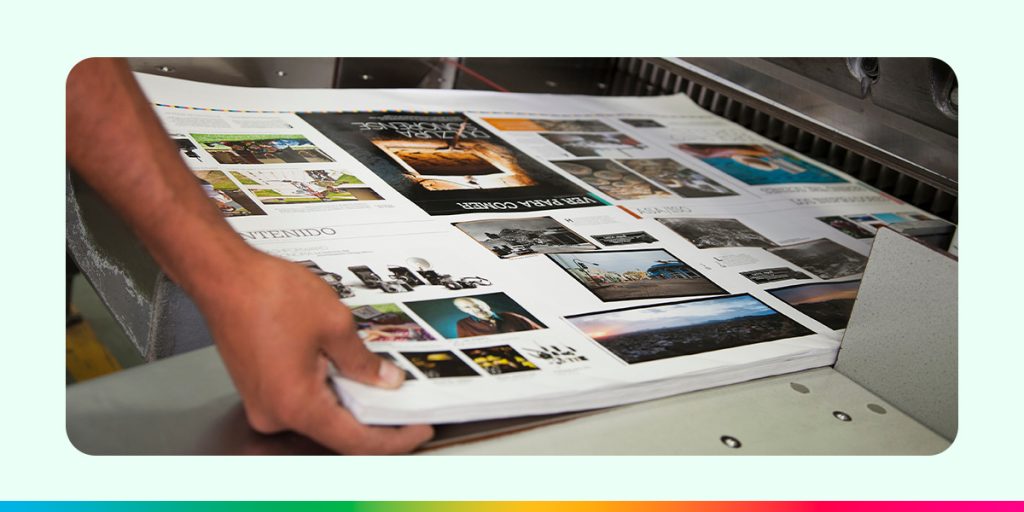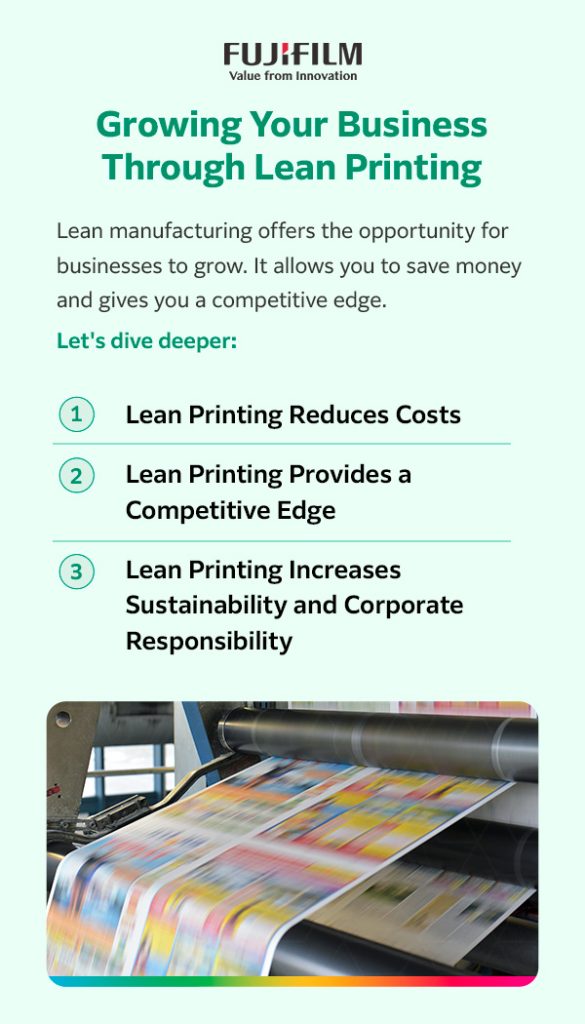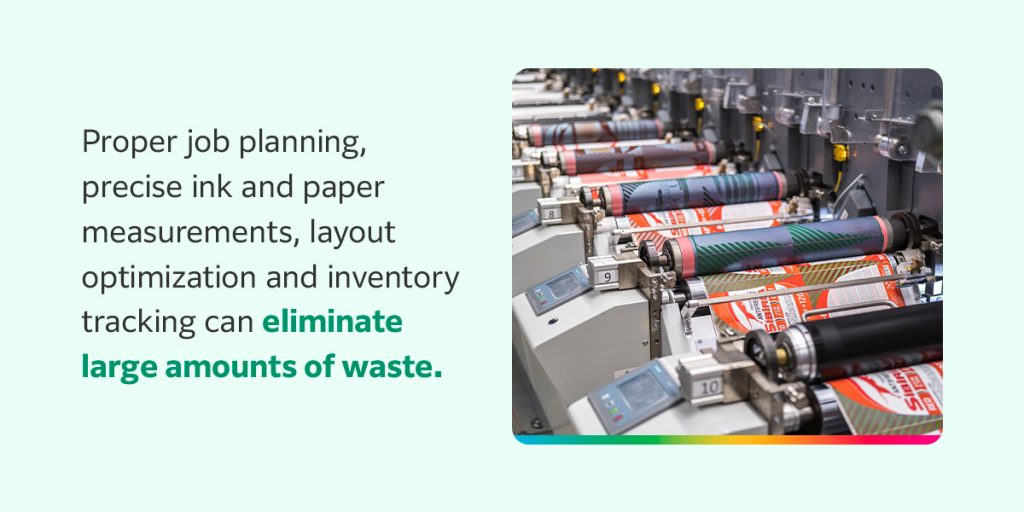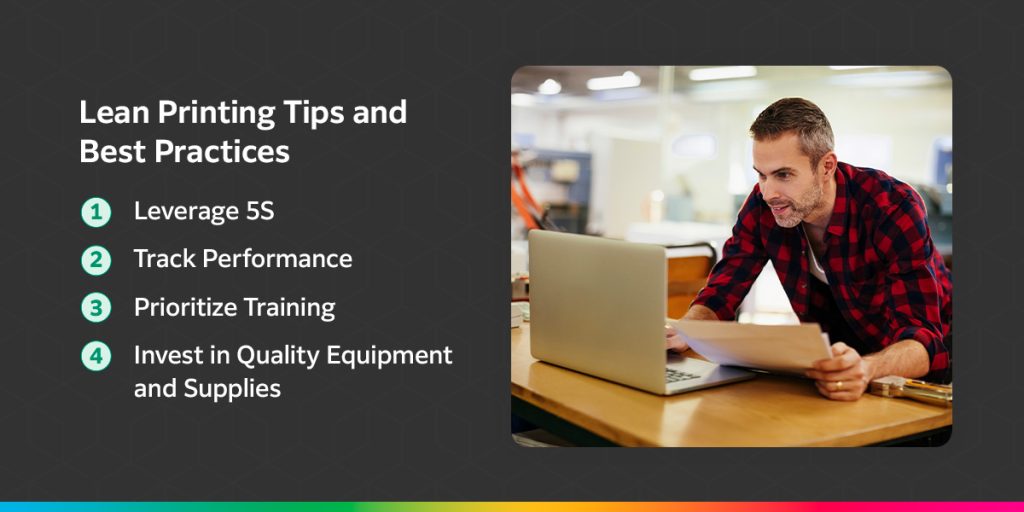
Lean manufacturing in pressroom printing can help you resolve common waste issues, particularly in offset printing. Though lean manufacturing is a popular concept in the printing industry, you may not understand how to implement a practical lean strategy for your business.
If you understand the basics, lean printing is a straightforward technique for driving growth. Learn what it means and how to employ lean methods to eliminate waste in your printing business.
To understand lean printing, you need to know about lean manufacturing since lean printing is a specific application of lean manufacturing. In other words, lean printing is applying principles of lean manufacturing to the graphic arts and printing industry.
Organizations worldwide across all industries use lean manufacturing to maximize value and reduce waste throughout production. Lean printing allows businesses to improve efficiency, reduce costs and ultimately, improve customer satisfaction. It can also help companies to grow in competitive markets.
The printing industry is known to be resource-intensive. Various complex processes can result in inefficiencies and waste if not properly managed. Whether dealing with inventory management, production planning or material handling, optimizing each stage to maximize resources is best.
Implementing lean manufacturing principles enables printers to streamline their production processes, encourage continuous improvement and reduce waste. However, this is only possible if you understand lean manufacturing principles and how they work.
Lean manufacturing is effective in reducing waste in the print industry. Here are four classic examples:
Knowing your client’s needs enables you to provide support while saving resources. Within the graphic arts and printing industry, lean methods allow the use of the right resources for a given project. For example, you can determine the quantity of papers and inks you need to complete each print job. You may adjust font sizes, layouts and margins to minimize raw material consumption. Eliminating unnecessary black spaces and coloring seems minimal, but it can save significant amounts of ink on a large scale.
Lean printing decreases raw material use in other ways, too. Classic examples include double-sided printing and the use of recycled materials. Double-printing cuts down the sheets of paper required for the project. Recycled paper and eco-friendly inks also reduce the demand for raw materials derived from virgin sources.
Optimizing printing can reduce the time and material resources used on each project. This directly impacts the energy employed in running printing equipment. Lean methods also encourage business owners and managers to invest in energy-efficient equipment because they reduce utility costs.
Another vital consideration is process automation. Automation is an effective way to streamline workflow since it removes inefficiencies and increases productivity. By automating processes, businesses reduce the time and energy spent executing tasks.
Wastes like unused inks, solvents and other chemicals are typical in the printing industry. One fundamental aspect of lean printing is using just the right amount of resources — not more, not less. This has many associated benefits, including the following:
Lean methods help you examine the printing process and implement strategies to streamline workflow and eliminate unnecessary bottlenecks. With lean strategies, you can create a standardized system to improve consistency after identifying what works best. You can reduce errors and increase productivity. Your processes become predictable and second nature to each employee — your secret to success.

Lean manufacturing offers the opportunity for businesses to grow. It allows you to save money and gives you a competitive edge. Lean printing also promotes sustainability and corporate responsibility. Let’s dive deeper:
Applying lean techniques to your business can save you in many ways, including the following:
Lean printing provides an edge over your competitors and promotes steady growth. This competitive edge is manifest in many ways, including the following:
Lean printing increases sustainability in many ways:
These factors can reduce your carbon footprint and make your processes environmentally friendly.
Lean printing also promotes corporate responsibility. Employees become critical participants in the various processes, giving them a sense of accountability. Lean methods encourage companies to engage with local communities through sustainability campaigns and other beneficial programs. This outreach helps build a positive reputation and long-lasting relationships.
Offset lithography is a valuable technique, but it has some challenges with material loss, defective products and increased expenses. Here are five examples of common waste issues:

Lean processes make a significant difference in reducing waste in pressroom printing. Proper job planning, precise ink and paper measurements, layout optimization and inventory tracking can eliminate large amounts of waste. Investing in quality printing equipment can also reduce misprints and decrease energy consumption.
There are five primary steps to incorporating lean methods. These are:
Customers are willing to give something valuable in exchange for a product or service. Search for your customers’ actual or latent needs and find solutions. In some cases, customers are unsure what they want. Others know their desires but cannot articulate them effectively. These issues are particularly prevalent when it comes to novel products or services.
Every business owner or manager is responsible for examining their audience and ascertaining how to satisfy their needs. You can use various techniques to define what the customer finds valuable, such as surveys, interviews and digital analytics.
The mapping and analysis of value streams is an undertaking focused on gaining insight into the current state of workflow. The purpose is to help management and workers “see” the flow of work and identify bottlenecks in work tasks that are often difficult to visualize and to analyze that flow from a customer-centric perspective that is explicitly focused on adding value and reducing waste.
Knowing what your customers value and the production of print lets you identify the activities contributing to those values. Any activity that does not add value may be considered as waste. There are two categories of waste. The first is non-value added but necessary waste. The second is non-value but unnecessary waste. Strive to reduce the former and eliminate the latter to exceed your customers’ expectations while cutting down expenses.
After reducing waste, ensure the remaining steps are equally smooth. In other words, you must remove interruptions and delays as well. You can use various strategies, including breaking down steps, distributing the workload, establishing cross-functional teams, and building an agile and adaptive workforce.
This stage focuses on improving time to market. Time to market is the duration it takes to conceive the product and deliver it to the customer. The advantages are that customers receive their requests timely while you reduce inventory stockpiling. You will spend less on inventory acquisition and management.
Lean manufacturing is a continuous process aimed at achieving the best possible results. Hence, it’s best to implement strategies for consistency. Make the procedure central to the organization’s culture and ensure each employee participates. In addition, always find ways to optimize workflow. This is arguably the most critical step.

Here are four tips for implementing lean in your printing business:
5S is a lean technique for improving workplace efficiency. It stands for sort, set in order, shine, standardize and sustain. The concept originated in Japan and has proven helpful in the printing industry. Here is a breakdown of what each step means:
The best way to ensure continuous improvement is by tracking overall performance. Metrics can help you identify deficiencies and serve as proof of concept. You can establish key performance indicators (KPIs) to measure performance and monitor the processes. Leveraging data in determining trends and areas of improvement allows you to drive the business closer to its goals.
Lean printing is a continuous process, meaning there will be changes along the way. Engaging employees in ongoing training programs designed to sharpen their skills is essential. You can use these programs to educate employees on emerging trends and system modifications. Organizational culture is also critical in how employees receive and implement your lean strategies.
The success of your lean strategy rests heavily on the equipment and supplies you use. Quality machines help you avoid delays, making you reliable. High-precision equipment also reduces errors and defects, eliminating unnecessary waste. Energy-saving printers can decrease utility bills and carbon footprint, and quality supplies can improve your final production. The right resources make your processes predictable and mitigate waste generation.
Lean printing enables you to optimize raw material usage, reduce energy consumption, decrease waste generation and improve efficiency. It helps you maintain sturdy growth, giving you a competitive edge. While developing practical processes is essential, investing in the best equipment and supply to improve output is equally necessary.
FUJIFILM Graphic Communication offers comprehensive development efforts throughout the production cycle. From printing materials to systems and workflow, we help printing businesses drive growth. Do you want to increase productivity with effective lean printing methods? Contact us today!